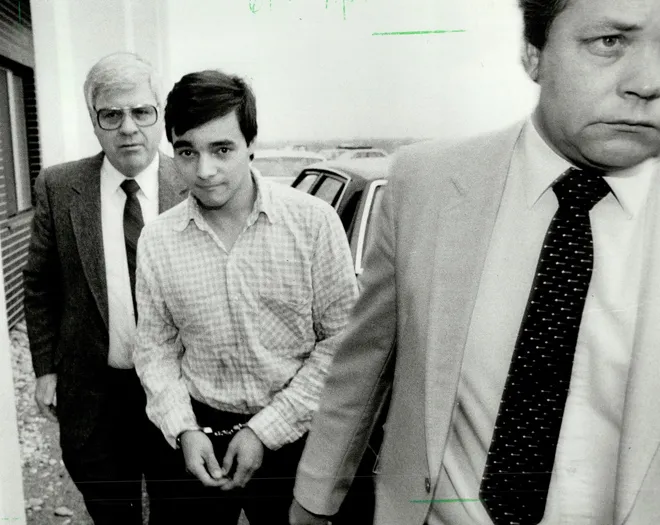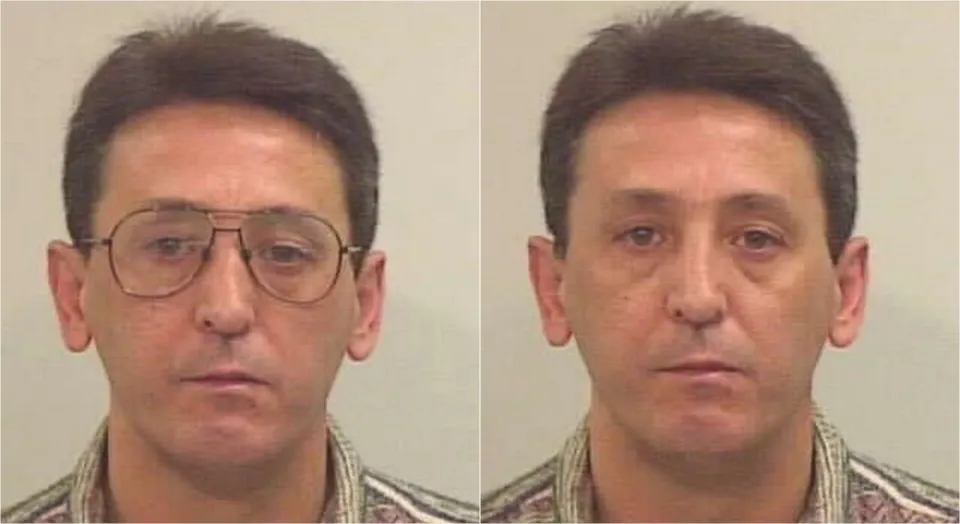36 years after the 9-year-old girl was murdered, her neighbor Guy Paul Morin was finally able to breathe a sigh of relief because he ultimately ended the suffering he had endured by being viewed as the deranged killer.
The Mysterious Disappearance

Christine Jessop was a 9-year-old girl living in the quiet small town of Queensville, north of Toronto (Ontario, Canada). Christine had bright eyes, liked baseball, and riding her bike. The little girl loved animals and dreamed of growing up to become a veterinarian.
On the afternoon of October 3, 1984, Christine’s mother took her younger brother to a dentist appointment, so she told Christine to go home after school. Listening to her mother, the girl returned, put down her backpack, and then disappeared.
When she got home, Christine’s mother saw her daughter’s backpack on the bed but couldn’t find Christine anywhere in the house. She called Christine’s friends but no one knew where she was. One girl who went to school with Christine said she saw her walking home after getting off the school bus that afternoon.
Christine’s mother began to feel scared. “There was something that made me think something wasn’t right,” she said. After searching everywhere with no results, the mother quickly reported it to the police.
Immediately, a widespread search was conducted. Nearly the entire town joined police, firefighters, and volunteers combing through every nook and cranny and surrounding fields, even as night fell. No one knew that by then, Christine was no longer in town.
Christine’s backpack was left at home, indicating she had made it back. However, nearly 3 months later, her whereabouts remained unknown.
A Body in the Field
Until December 31, 1984, as people prepared to ring in the New Year, all hope for Christine’s parents was extinguished when police announced that a farmer had found her torn clothing and decomposing body in a field in Sunderland, Ontario, about 55km east of the victim’s home.
According to the autopsy results, Christine had been sexually assaulted and stabbed multiple times. Once again, most townspeople attended Christine’s funeral to share in the grief her family was suffering.
Under pressure from many sides, the Canadian police were determined to solve the case. However, at that time DNA technology was not advanced enough to provide accurate results from the samples collected from the victim’s decomposed body. They could only investigate potential suspects.
Police then presented several names to Christine’s mother, including people she might suspect. The first person the mother thought of was their neighbor, Guy Paul Morin.
Guy lived with his parents right next door to Christine. The 24-year-old man worked at a furniture manufacturing plant. He enjoyed beekeeping and playing trumpet in a community band.
Christine’s mother told police that he was an “oddball.” The Morin family lived rather reclusive lives. Guy also raised suspicions when he didn’t participate in the search for Christine or attend the little girl’s funeral like most other town residents did, despite being their next-door neighbor.

The Surprising Verdict
After Christine Jessop’s mother provided the name of their eccentric neighbor Guy Paul Morin as a suspect to the police, they investigated what Guy was doing on the day of the crime.
Guy’s parents said their son came home from work and immediately took a nap, then tidied up around the house until dinner time. When police questioned Guy about Christine’s case, his cold demeanor raised their suspicions.
Two months later, Guy was arrested and charged with first-degree murder despite the man’s steadfast denial of any involvement in the neighbor girl’s death.
A full year later, Guy stood trial. Prosecutors portrayed him as an oddball obsessed with the young neighbor girl in a sexual way. Evidence against Guy included a hair sample found on Christine’s clothing that was microscopically consistent with Guy’s hair, as well as three head hairs and a fiber consistent with Christine’s hair and clothing found in Guy’s car.
Two psychiatrists also testified that Guy suffered from moderate schizophrenia and was capable of stabbing Christine while hallucinating.
Furthermore, the jury heard testimony from two of Guy’s fellow inmates claiming he had blurted out anguished confessions in the middle of the night in their shared cell that he killed Christine.
However, Guy’s lawyer argued that on the day the victim’s mother called the police at 4:10 pm, Guy’s work timecard showed he didn’t leave the plant until 4:15 pm, leaving no time to commit the crime. Moreover, the hair and fiber evidence had no definitive value, merely representing the subjective opinion of the naked eye with no conclusive match. Guy’s cold demeanor towards the case resulted from his schizophrenia.
In less than a day of deliberation, the jury found Guy not guilty on February 7, 1986, and he was immediately released.
The Overturned Verdict
The acquittal shocked the victim’s family, police, and media. At that point, there was a common belief that Guy was the killer. An appeal was filed to the Supreme Court and a new trial began.
A police officer who monitored Guy insisted he had an extremely cold attitude towards the case. Christine’s mother said at her daughter’s funeral she heard the desperate, anguished cries of a man, which Jenny believed came from Guy feeling remorseful for his brutal act.
The woman and her son also changed their testimony about what time they arrived home the day Christine went missing. Previously she said they discovered her missing at 4:10 pm and called the police, but now said they couldn’t recall the exact time and widened their estimate to 5:35 pm. This significantly altered the window of opportunity for Guy to get home from work and abduct the girl.
Guy stated he could not have had enough time to drive home from work, abduct Christine, transport her 55km away, sexually assault her, stab her to death, and still make it home for 5:30 pm dinner. However, the jury, considering the mother’s revised timeframe, felt Guy could have been capable.
Ultimately, Guy’s original acquittal was overturned due to jury error.
On July 30, 1992, Guy Morin was convicted of first-degree murder and sentenced to life in prison. Even then, he continued to maintain his innocence.

A Decade of Injustice
On July 30, 1992, Guy Paul Morin was convicted of first-degree murder in the death of his young neighbor Christine Jessop. Until then, Guy had continuously proclaimed his innocence, followed by a string of appeals.
18 months later, on his third appeal, Guy received a positive result. Previously, investigators had unsuccessfully attempted DNA testing on Christine’s clothing multiple times. But by this point, advanced DNA technology allowed for more sophisticated testing. The results ultimately proved the DNA sample definitely did not belong to Guy.
Authorities decided to reinvestigate the entire case. They discovered the testimonies years earlier from Guy’s jail inmate cellmates were fabricated. These men admitted Guy had never confessed to killing Christine.
Additionally, the hairs and fibers found in Guy’s car were determined to be from another young girl, who admitted she had previously climbed into his car to play and was shooed away when caught.
With this new evidence, the court found Guy not guilty, a decade after he became the prime suspect. Guy was awarded $1.25 million in compensation.
The Surprising Culprit

Afterward, the investigation into Christine Jessop’s death was reopened from the start but made no progress.
From then on, outside of Christine’s loved ones, the 9-year-old’s tragic death faded from public memory. Christine’s parents divorced and sold their Queensville home. Guy used his compensation to purchase farmland, married a member of his innocence support group, and had two sons. He also started a small business and worked as a maintenance man at Toronto’s Pearson Airport.
In October 2020, 36 years after Christine’s murder, Canadian police submitted the semen sample from her clothing to a lab utilizing genetic genealogy to aid in solving cold cases.
Using this sample, the lab built a comprehensive DNA file, analyzed the genetic data, and cross-referenced it against genealogical records.
After 6 months of analysis and genealogical cross-checking, police finally identified the suspect as Calvin Hoover – a man who had never been considered a suspect in Christine’s murder before.
When police announced these findings, Christine’s relatives were stunned, as Calvin had been a close friend of the family. For months after her disappearance, he acted distraught, enthusiastically joined search parties, and comforted her grieving parents at their home.
Though the suspect was identified, police discovered Calvin had passed away in 2015. So details surrounding Christine’s murder, including motive and whether he had other victims, remained unclear.
It wasn’t until the truth about the case finally came out that Guy could truly breathe easy. For years, he avoided media interviews or public appearances. In his final interview, he stated: “I was angry at the injustice, but I knew my day would come. I’m grateful the police never gave up on the case and ultimately got to the bottom of it. When DNA exonerated me, I knew this method would one day unmask the real killer.”









